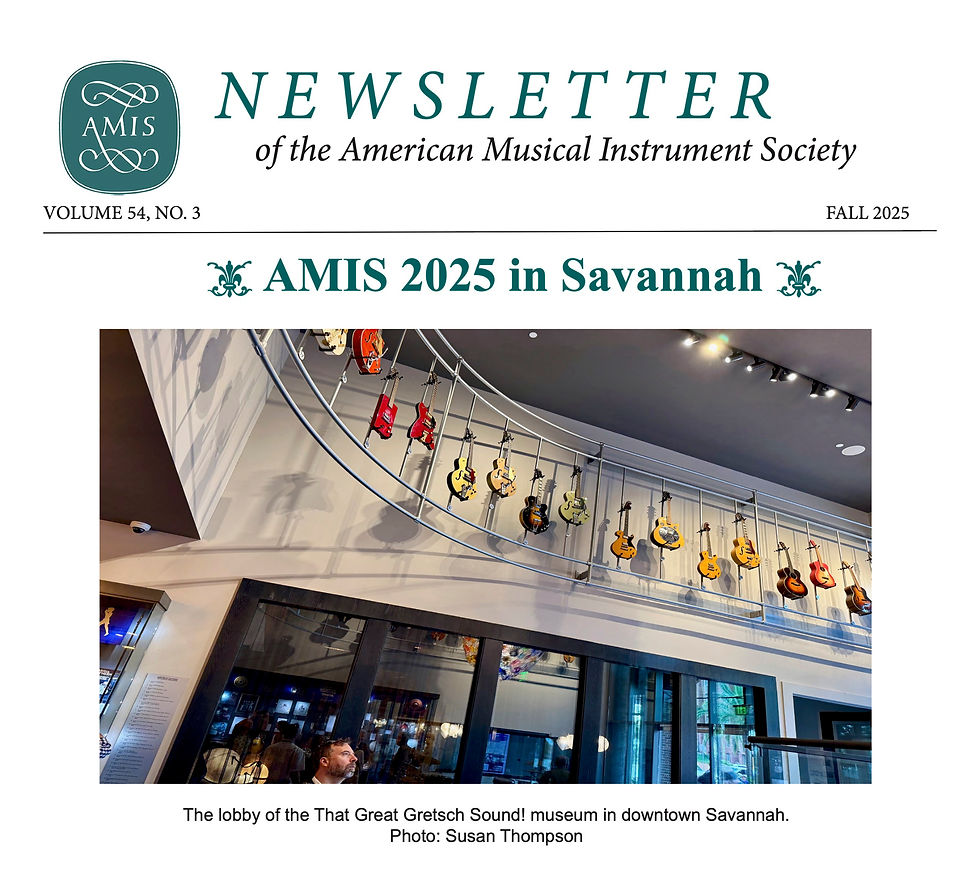Report from the Virtual AMS/SMT Conference
- AMIS Blogs

- Dec 6, 2020
- 3 min read

Attending the 2020 AMS/SMT joint conference with two computers and a monitor set up (complete with moving boxes, still not fully unpacked)
Hello AMIS friends!
The fall conference season is upon us once again, albeit without the long flights, restaurant explorations, and hotel lobby hangouts. We just concluded the joint conference of the American Musicological Society (AMS) and the Society for Music Theory (SMT). Organology and timbre studies were well represented this year.
A little about how it worked this year. The decision to move online was made pretty quickly after the beginning of the pandemic, and I must say I was quite impressed by the overall organization of both societies. Though it was joint, registration was separate, and each society ran their own conference platform and website. Sessions were coordinated, with a handful of plenary and joint sessions between the conferences. AMS averaged about six or seven simultaneous sessions every hour, while SMT had averaged about three or four. That does seem lower than usual, but I confess, these are impressions not statistics. The usual four days were stretched across two consecutive weekends, allowing plenty of recuperation and relieving potential conference fatigue.
The absolute best part of the online conference format is that the entire hour of each session was devoted to Q&A. Attendees were expected to have watched the 20-minute video presentations uploaded by the speakers before the session, then bring their questions to the discussion hour. If I have one hope for future academic conferences it is this: instead of the standard 30 minutes allotted to each speaker being a 20+10 paper then Q&A, use a pre-circulated video presentation of the paper and allow all 30 minutes to be discussion (alright, perhaps a 5-minute summary of the paper first).
Other than that, for me, an online conference will never replace an in-person event. I missed out on the randomness of bumping into colleagues in the halls and enjoying conversations at the coffee table. There’s nothing like seeing faces, shaking hands, and laughing together; hopefully these will not be things of the past. But everyone is doing the best they can considering the circumstances, and I applaud the leadership and the people that implemented the plan of both the AMS and the SMT. The organizers of this year’s AMS/SMT were thoughtful; there were virtual coffee breaks to relax with friends, meet new people, or speak to one of the chairs of AMS Study Groups or SMT Interest Groups. There were also morning yoga sessions, “Fun Parties” with prize giveaways, and “Listen and Unwind” sessions.
Inevitably, there were the few overlapping sessions I wanted to attend, but that’s always the case. To try to combat the overlapping sessions, I had two computers and an external monitor set up—it did not work. Alas, my valiant effort was thwarted by reality: I was not able to pay attention and participate in multiple sessions. But, a consolation prize of the online format is that conference presentations will remain online after the conference is over, so we can watch and listen even if we could not participate.
In sum, the AMS and SMT did a wonderful job navigating the uncertainty of the pandemic. Having an online conference was better than not having a conference, but I look forward to seeing my friends again in person, when it is safe for all. Until then, we must continue to be vigilant and do our personal part for public health.
A Brief OSG Report for AMIS
By Matthew Zeller and Lidia Chang
The (soon-to-be-applied-for) Organology Study Group of the AMS had our third annual event at the AMS/SMT 2020 conference. We held a reading discussion of three pre-circulated papers to actively dismantle the language barrier between subdisciplines and give voice to diverse perspectives through conversation. The conversation was genial and evolved organically. We focused on musical instruments as the subject or object of study and what it meant to approach instruments from differing perspectives. We spent less time talking about Beethoven’s Erard piano (the subject/object of two of the readings) than expected; instead, we focused on brass, woodwind, and bowed strings. All in all, it was a healthy and robust conversation. The next step for the OSG is to apply to the board of the AMS for official status as a Study Group, stay tuned for updates.
Matthew Zeller is an organologist, musicologist, violin historian, and bow maker. Matthew Zeller is a Postdoctoral Fellow in the ACTOR Partnership at McGill University, Schulich School of Music. His primary research areas include timbre and timbral function in music, Klangfarbenmelodie and the Second Viennese School, music cognition, and musical instruments.



Comments